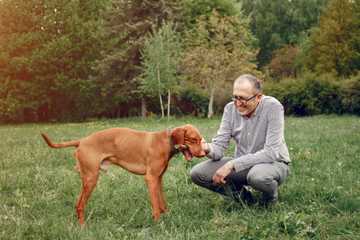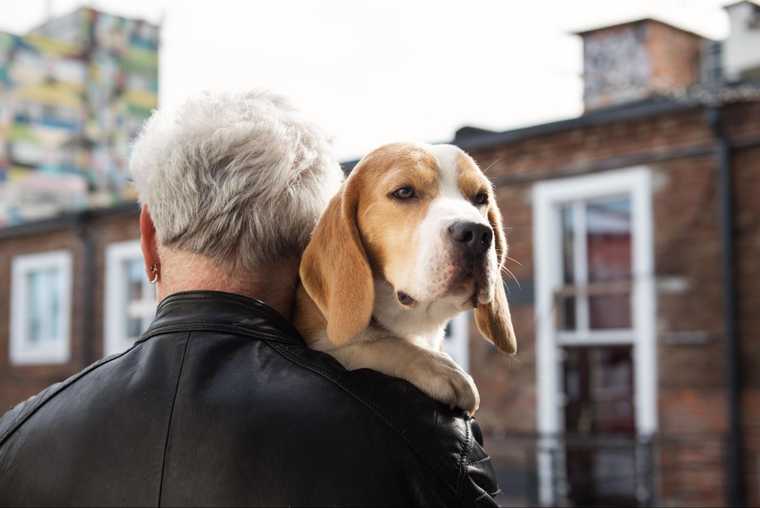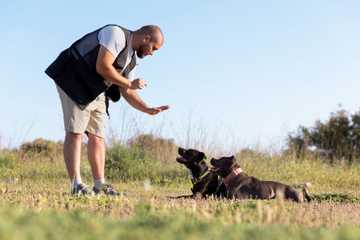A Complete Guide to Training an Older Dog

Who hasn’t heard the phrase, “You can’t teach an old dog new tricks?” In reality, this idea can’t be any further from reality. Senior doggies are teachable; they have longer attention spans and focus better due to lower energy levels.
So, whether you adopt a senior dog from a shelter or need to eliminate the unwanted behaviors of your furry friend, obedience training for older dogs is possible and can be effective. Keep reading to learn more.
Understanding Older Dogs and Training Needs
Many of us believe that training sessions are only necessary for young puppies. Indeed, a fast-developing pup’s brain absorbs new skills like a sponge, and many furry friends learn basic obedience commands during their first year of life. However, there’s no need to stop training your furry friends once they reach adulthood.
Here are some benefits of training older dogs:
- It provides mental stimulation and helps build new neuroconnections.
- It strengthens a bond with their owner and keeps them engaged.
- It helps correct unwanted behaviors or deal with disruptive habits.
- Adopted older dogs may lack obedience training, which you can introduce at any point in their life.

Training adult dogs has unique aspects that pet parents should be aware of. Before you start a new program (especially a physically challenging one), consult a vet to evaluate your pet’s health status and adjust the program accordingly.
Older furry friends may also have trouble hearing or seeing well, impacting how fast they respond to your cues.
Finally, possible cognitive changes should be considered, especially in dogs of advanced age. Just like humans, older dogs may need more time to process new information and understand the concepts of the commands. Stay patient and slow down the process if necessary.
Preparing for Senior Dog Training
Choosing a proper training location is vital for success. Start the sessions in a quiet, distraction-free place where your dog can stay focused for a long time. Owners of older doggos prone to escaping should choose enclosed or fenced areas.
Another thing to consider is the adult dog training schedule. Keep the sessions short but frequent. This type of schedule allows your dog to rest in between sessions and stay motivated, and it boosts their engagement.

Finally, consider the structure of your program. Identify the tricks and commands you want your furry companion to master. Next, you should arrange the training process in a logical order that helps your pet utilize the skills they acquired before learning new commands and tricks.
Building a Strong Foundation for Training an Older Dog
Using positive reinforcement techniques, regardless of age, is essential. So, start with choosing the right motivation for your furry friend. Some older pets respond well to food, while others are more interested in toys. In addition, you can pair the rewards with a clicker to mark a desired behavior.
Some points to consider:
- For food-motivated doggies, choose treats with high-nutrition value, like Omega-3 fatty acids and antioxidants.
- Use engaging toys to reward the desired behavior.
- Some pups do well with physical touch (you can pet or message them); it’s enough for them to stay motivated.

How to Train a Grown Dog: Housebreaking and Crate Training
Having an adult doggo that isn’t potty-trained can turn into a full-scale disaster. Luckily, you can housebreak a dog of any age, and using a crate can help you do that. So, let’s discuss this first.
Crate training for older dogs
Dogs are den creatures, so having a safe space of their own is, in a way, dictated by their instincts. Pet parents can use these natural tendencies to their advantage in crate training. Though it may be viewed as limiting freedom of movement, a crate can become a place of rest and comfort.
Crate training older dogs helps with the following:
- Potty-training
- Creating a safe place for a furry friend in a stressful environment, like when fireworks are around or in a thunderstorm
- Transporting a pet from one place to another
- Controlling disruptive behavior connected with other people visiting your place

Install a crate in a quiet, well-ventilated area of your house. Introduce your pet to the crate by placing a food lure inside and encouraging them to enter. Gradually increase the time in the crate, and then start closing the door.
Note: If your furry companion was adopted recently, make the process slower, as they might have trauma from being enclosed in kennels or other areas in their previous homes.
How to train older dogs to stay in a crate:
- Choose the proper crate for your friend.
- Let the dog sniff around it and get to know the crate without entering.
- Entice your doggy to the crate with rewards, such as treats or toys.
- Start offering the pet meals inside the crate.
- Close the door for short periods and while they’re entertained.
Crate-trained older dogs can spend up to 6 hours inside per day. However, you should check whether the doggo feels comfortable in the crate and provide them with regular toilet breaks and opportunities to exercise.
Potty-training an adult dog using a crate
Training an adult dog to take potty breaks outside is much easier if they’re familiar with a crate. Doggies want to keep their den clean and avoid using a place where they rest as a toilet. So, placing a pet in a crate helps them control their bladder and wait till you take them out to do their deed. Also, ensure you’ve desensitized the crate first. Otherwise, you might end up creating a new problem.
Potty-training without a crate goes like this:
- Understand where the dog is used to do their business. Choose that kind of texture for potty training them (e.g. if they are rescued and were used to pee in the kennel, they’ll probably do it in cement).
- Take them to the correct place to pee every 2 hours.
- Reinforce them when they do it in the correct place.
- Redirect the dog to the correct place whenever they do it in the wrong place.
How to Train an Adult Dog: Leash Training and Walking
If you adopt a senior doggy from a shelter, they may suffer from insufficient socialization. Some shelter dogs may not have experience of leash-walking at all. With some patience and dedication, you can achieve great results.
The leash training techniques for an adult dog are:
- Before you start the sessions, allow your pet to sniff the collar and the leash to reduce their anxiety around these objects.
- Teach your pet to walk by your side, practice stopping and resuming walking, and respond to the basic commands.
- Use treats and rewards to encourage the practice.
- Avoid pulling the leash or punishing your doggo for misbehavior.
Obedience Training for Adult Dogs
Teaching your dog basic obedience commands, such as sitting, lying, and dropping it, is always a good idea. These commands are crucial for ensuring your pet’s safety, controlling their behavior, and setting the foundation for further, more complex training. However, obedience training for an older dog has some quirks.

Some older doggies experience a decline in their cognitive functions. That’s why you should take it slow. Break down the command into small doable parts and move from one to another only when your pet has mastered the previous step.
To help your furry companion stay focused, use positive motivation through treats and toys. Create a regular exercise schedule to reinforce the results. Remember, older dogs may require more patience from you to guide them along the way. Make sure you introduce plenty of mental, olfactory, and sensory stimulation to help them feel successful and confident. Also, mental stimulation helps improve and maintain cognitive function.
Senior Dog Training Tips to Overcome Challenges
Training a senior pet presents unique challenges that pet parents should know.
Disruptive behaviors
Chewing, excessive barking, or scratching aren’t limited to puppies. Adult and older doggies can also display such behaviors. To tackle the issue effectively, you should identify the possible reason triggering the reaction.

A senior furry friend may bark or chew due to:
- Separation anxiety
- Boredom
- Lack of exercise
- Underlying medical condition
Depending on the cause, you may change how you interact with your furry friend, spend more time together, or address a vet for medical assistance.
Physical limitations
Senior dog training should change according to your pet’s health status and underlying chronic illnesses. Thus, older furry friends with joint issues should stay away from jumps. Those suffering from heart-related diseases benefit from moderate and low-intensity exercises. Visually or hearing-impaired pets need more guidance to understand your cues.
If you have a furry companion with vision loss:
- Pay extra attention to your pet's safety (dog-proof the house and avoid slippery floors).
- Rely on your pet’s sense of smell (you can use scented oils to mark specific objects).
- Talk to your doggie and teach them basic commands.
- Use a textured rug to map your house to the dog.
So, teaching a senior/adult pet new commands is possible. However, dog parents should know what the quirks of the process are. Consider your doggy’s health status and previous background to set up a plan suitable for you and your canine companion.
Use positive reinforcement methods, such as praise and rewards, to build motivation. Stay patient and positive during the process. If you follow these tips, older doggies will surprise you with how well-trained they can be.
Frequently Asked Questions
Can older dogs be trained?
Pups can learn new commands and behaviors regardless of age. You may need to adjust your sessions to meet your pet’s engagement-related needs, such as slowing down the training or skipping the tricks requiring rigorous exercise.
What age is too late to train?
It’s never too late to train a doggy if you’re willing to dedicate time to the process. If you face any challenges in the training process, consult a professional dog trainer for help.
Is it easier to train a puppy or an older dog?
Some older furry companions are easier to train because they have longer attention spans; others may need more time to comprehend the command as their cognitive functions decline.

Passionate team dedicated to help pet owners raise safe and obedient dogs, fostering meaningful connections with their furry companions.

Certified dog trainer, exclusive positive reinforcement methods & tackling aggression problems.